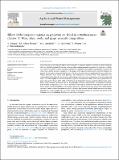Por favor, use este identificador para citar o enlazar a este item:
http://hdl.handle.net/10261/266306COMPARTIR / EXPORTAR:
 SHARE SHARE
 CORE
BASE CORE
BASE
|
|
| Visualizar otros formatos: MARC | Dublin Core | RDF | ORE | MODS | METS | DIDL | DATACITE | |

| Título: | Effects of the irrigation regimes on grapevine cv. Bobal in a Mediterranean climate: II. Wine, skins, seeds, and grape aromatic composition |
Autor: | Lizama, V.; Pérez-Álvarez, Eva Pilar CSIC ORCID; Intrigliolo, Diego S. CSIC ORCID; Chirivella, C.; Álvarez, I.; García-Esparza, María José | Palabras clave: | Bobal Regulated deficit irrigation Tannins Anthocyanins Skin and seed polyphenols Aroma compounds |
Fecha de publicación: | 1-oct-2021 | Editor: | Elsevier | Citación: | Agricultural Water Management 256: 107078 (2021) | Resumen: | This study aims to determine the effects and the response to irrigation regimes (i) rainfed, (ii) deficit irrigation (DI), and (iii) full irrigation (FI) on wine and grape skin, seed and aromatic composition of grapevine cv. Bobal. The results show that the deficit irrigation treatment can modulate some important parameters of grapes and wine colour, and the aromatic composition of the grapes, with respect to rainfed and/or unlimited irrigation. In general, alcohol concentration and total acidity of the wines decreased with the application of water, while berry weight increased. Wine colour, total phenolics, and anthocyanins increased when water application was restricted due to the effect of water stress on anthocyanins, tannins and colour parameters of the grape skins and seeds. The water regime did not affect the seed polymeric concentration values, while the polymerization of grape skin tannins (higher mDP, aMW and %G) from the irrigated treatments, positively affected must astringency. Some aromatic precursors such as benzaldehyde, guaiacol, 4-ethylphenol, 4-vinylphenol, α-ionone, γ-decalactone, syringaldehyde, and vainillin increased in the irrigated treatments with respect to rainfed. Benzanoic acid, 3-hydroxybenzaldehyde and octanoic acid content also increased with respect to the full irrigation treatment. These increases can favour metabolic pathways that enhance specific volatile aromas in the wines, affecting their sensory quality. The overall the results presented demonstrate the important role played by the irrigation regime in modulating Bobal grapes and wine composition. | Descripción: | © 2022 The Authors. | Versión del editor: | http://dx.doi.org/10.1016/j.agwat.2021.107078 | URI: | http://hdl.handle.net/10261/266306 | DOI: | 10.1016/j.agwat.2021.107078 | ISSN: | 0378-3774 |
| Aparece en las colecciones: | (CEBAS) Artículos (CIDE) Artículos |
Ficheros en este ítem:
| Fichero | Descripción | Tamaño | Formato | |
|---|---|---|---|---|
| Effects_of_the_irrigation_regimes_Lizama_PV_Art2021.pdf | 1,61 MB | Adobe PDF |  Visualizar/Abrir |
CORE Recommender
SCOPUSTM
Citations
17
checked on 13-may-2024
WEB OF SCIENCETM
Citations
14
checked on 28-feb-2024
Page view(s)
33
checked on 18-may-2024
Download(s)
81
checked on 18-may-2024
Google ScholarTM
Check
Altmetric
Altmetric
Este item está licenciado bajo una Licencia Creative Commons

